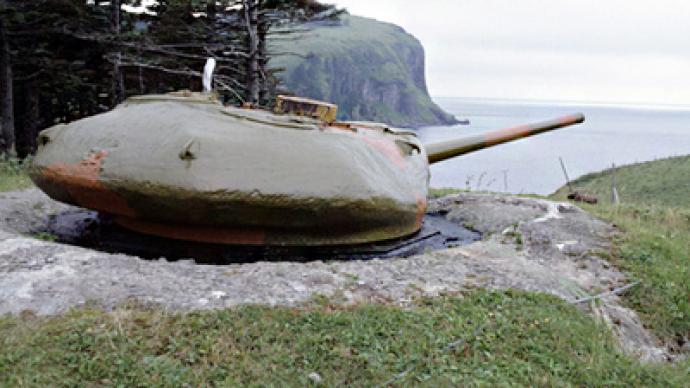Russia to beef up military presence on contested Kuril Islands

In a move that is expected to attract a heated response from Tokyo, Russia’s General Staff chief has announced plans to rearm and modernize its military grouping on the disputed Kuril Islands, which fell to Soviet control in the aftermath of WWII.
Russian General Staff Chief, General Nikolai Makarov confirmed that construction of two garrisons will begin in the second half of 2011 and finish next year, adding that military bases on Iturup and Kunashir – the largest of the island group – will accommodate new forces and provisions for the 18th machine gun-artillery division."The Defense Ministry's plan for the Kuril Islands has been confirmed,” Makarov told Interfax-AVN. “It [the reconstruction] is intended to continue for four to five years.”"Modern barracks, housing, parking lots and arms depots will be constructed in the Southern Kurils," Russia’s highest ranking military officer said. "Concurrently, the aging weapons and military hardware will also be removed," Makarov added.Earlier it had been reported that President Dmitry Medvedev instructed Defense Minister Anatoly Serdyukov to equip the Kuril military units with the modern weaponry required for guaranteeing the security of the islands.The military contingents based in the Southern Kurils will be switched to the latest state-of-the-art weaponry, Makarov revealed at the press conference."The grouping based in the Kurils will have a totally new look by 2014, or 2015 at the latest, and will possess ample modern weaponry," he said, saying that the projected modifications will provide a “reliable shield” for Russia from all directions. "We plan to deploy all weapon systems [on the islands] that will provide a solid and reliable shield to Russia's security in the sea, in the air and on the ground," the general said.The most advanced systems will start arriving in Iturup and Kunashir as early as 2011, Makarov continued. "We will supply the most advanced systems and military hardware to the islands within the next three to four years, including the Bastion missile systems, as new weapon systems will be arriving under the state defense order," he said.Meanwhile, Markarov said the numerical troop strength of the grouping based in the Kurils will not be increased, “but our grouping's potential will increase manifold.”Earlier reports suggested that in addition to the Bastion missile system, Russia would be fortifying the Kurils grouping with the Land Forces' air defense means, including Tor-M2 surface-to-air missile systems and Mil Mi-28N Night Hunter attack helicopters.In November, Medvedev became the first Russian leader to set foot on the disputed Kuril Islands, where he met with local residents in Kunashir, the second-largest of the four islands, and promised more investment for the region. In response to the visit, Japanese Prime Minister Naoto Kan called Medvedev's visit “regrettable,” and Russia's envoy was summoned.Moscow fired back, calling Japan's reaction to the visit "unacceptable". The dispute over the Kuril Islands, which Japan refers to as the Northern Territories, has been a thorn in the side of Japanese-Russian relations since the end of World War II, when the Soviet Army occupied Sakhalin and the island chain. In 1956, the USSR and Japan signed the Soviet-Japanese Joint Declaration, bringing to an end the state of war between the two nations. Moscow agreed to cede the islands of Shikotan and Habomai to Japan after the conclusion of a bilateral peace treaty. The treaty, however, was not signed because the government of Japan demanded that the Soviet Union cede all four islands. Meanwhile, the Far East federal district is under no threat of radioactive contamination following the nuclear disaster in Japan, according to experts of the Far East hydrometeorology and weather monitoring center.The situation in the region is being monitored by crews aboard Mil Mi-8 ad Mi-26 helicopters of the Far East Rescue Center.Overall, 630 stationary and mobile monitoring posts have been deployed, plus six aircraft and 26 ships, Interfax reported.Meanwhile, radioactive monitoring missions continue in the Sea of Japan and in the Pacific Ocean off the Kurils and Kamchatka aboard Russia’s Pavel Gordiyenko research vessel.On March 11, 2011, Japan suffered a 9.0 earthquake, followed by a devastating tsunami that severely damaged the Fukushima nuclear plant in the northeastern part of the nation, leaking radiation into the surrounding area and prompting fears of a major nuclear meltdown.Robert Bridge, RT













